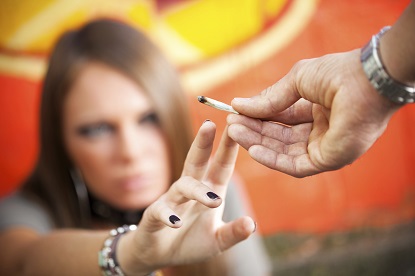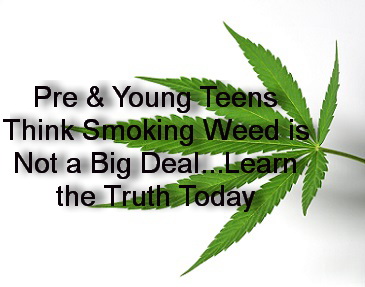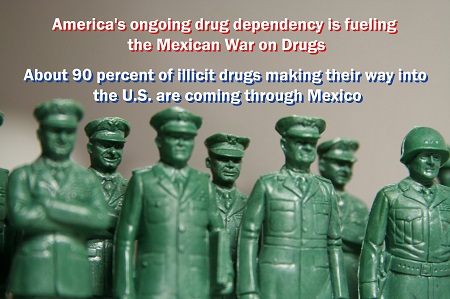The legalization of marijuana in many states has led to increased availability and experimentation. While many individuals with chronic pain related to a serious injury or illness attest to its medicinal uses, there are still concerns about the recreational use of the drug.
Research has shown marijuana to be a “gateway drug” because experimentation and recreational use can give a user access to more dangerous drugs that carry a higher likelihood of addiction and more serious side effects.
Marijuana Users Experiencing Psychosis Even After Use
Another important concern related to marijuana is research connecting its use to ongoing psychotic episodes. Some studies have shown that users can experience psychosis, not only while under the immediate effects of the drug but for extended period following use.
When teens begin using marijuana, however, the risks may multiply. Teen brains are still developing and any substance use can interrupt the important processes occurring in the structures of the brain, causing long-term cognitive impairment.
 A study led by Willemijn A. Van Gastel of the Rudolf Magnus Institute of Neuroscience at the University Medical Centre Utrecht in the Netherlands examined the effect of marijuana on mental health. While many studies have documented the connection between psychological problems and marijuana use, it is unclear whether cannabis use leads to an increased risk of mental disorders or if those with mental health problems are more likely to use cannabis.
A study led by Willemijn A. Van Gastel of the Rudolf Magnus Institute of Neuroscience at the University Medical Centre Utrecht in the Netherlands examined the effect of marijuana on mental health. While many studies have documented the connection between psychological problems and marijuana use, it is unclear whether cannabis use leads to an increased risk of mental disorders or if those with mental health problems are more likely to use cannabis.
The findings were published in Psychological Medicine.
The study analyzed surveys administered to over 10,000 students aged 11 to 16. The questions on the survey requested information about substance use, including cannabis, alcohol and cigarettes.
The students were also asked about other aspects of life, including whether they had experienced any problems at school or if there was any conflict at home. They were also asked about whether there was any history of molestation and other environmental risk factors for mental health symptoms.
Multiple Problems In School And Behavior Associated With Marijuana Use
The results of the analysis showed that there was an association between marijuana use and psychosocial problems. When other risk factors were taken into account, however, the association was not as strong. In addition, there were risk factors that were associated with negative psychosocial outcomes that were also associated with increased levels of marijuana use, including behavioral problems at school, missing school due to illness, truancy and alcohol and cigarette use.
The authors of the study believe that the presence of substance use, low self-esteem and difficulties with mood disorder symptoms could lead to psychosocial problems and marijuana use.
The researchers were surprised to find that there was no evidence of a relationship between the level of marijuana use and the level of poor outcomes in psychosocial measures. This suggests that the risk factors are a critical component in determining whether marijuana use leads to other negative outcomes.
Can Marijuana Use Indicate If A Teen Might Be At Risk For Mental Health Problems?
The authors note that the findings can be understood as a way to predict future negative behavioral and overall psychological and psychosocial wellbeing. In other words, marijuana use can indicate whether a teen might be at risk for mental health problems.
Drug Prevention And Education To Reduce Risk Of Substance Abuse
The findings are helpful for targeting teens that may be in need of prevention and education efforts to improve mental health and reduce the risk of additional substance use. Screening teens for substance use may also help identify possible areas of high risk for mental disorders.
While marijuana is often considered a harmless substance when used in moderation, many of the effects of the drug are not fully explored. Parents are encouraged to talk openly and often with their teens about the risks associated with marijuana use, including the possibility of mental disorders.
For nearly a quarter century now the state of Indiana has been conducting a youth substance use survey. The data is used to direct prevention and intervention strategies and to gauge how well those efforts are working. The most recent annual survey of alcohol, tobacco and other drug use, the Indiana Youth Survey 2013, reflects current trends in teen behaviors and attitudes and shows that some interventions are proving successful.
 The survey questioned 117,554 teens from private and public schools attending grades six through senior in high school. The survey is conducted in conjunction with the Indiana Prevention Resource Center who makes resources available to schools and communities aimed at curbing teen substance abuse.
The survey questioned 117,554 teens from private and public schools attending grades six through senior in high school. The survey is conducted in conjunction with the Indiana Prevention Resource Center who makes resources available to schools and communities aimed at curbing teen substance abuse.
Use of marijuana by teens (12 to 17 years) hit an all-time high in the state between 2008 and 2011. The good news is that the most recent survey shows that marijuana use is now falling among teens there. However, while marijuana use is dropping, its use is still seen as too high, and synthetic marijuana use is an increasing concern.
Synthetic Marijuana Use Dangerously Increasing
Synthetic marijuana is just what it sounds like — a man-made substance that mimics marijuana. It is made by drying plant material and then spraying it with chemicals which mirror the effects of marijuana and THC. The plant material is then chopped and marketed in stores as incense, but kids roll it and smoke it just like natural marijuana. In fact, the survey shows that teens are not substituting fake marijuana for real marijuana but are using the two drugs simultaneously.
This year’s survey included new questions related to risk factors and protective factors that influence teen drug use. Questions pertaining to the health of relationships and attitudes reveal the degree of risk or protection teens are experiencing. The attitudes of parents and friends about drug use influences teens greatly, as do how well relationships at home, school and among peers are faring.
Prescription Drug Abuse
The survey found that prescription drug abuse increases with age. Less than two percent of sixth graders reported abusing prescription drugs, but more than 14 percent of seniors admitted using. The survey was specific in asking teens if they bought prescription drugs from friends or obtained them from family members. Since a major protective factor against prescription drug abuse is a teen’s perception of danger, the survey highlights the need for more information and better education strategies letting kids know just how dangerous misuse of prescription drugs can be.
Other news found in this year’s survey included success in lowering the numbers of teens who engage in gambling (online, lottery, slot machines etc.). Teen gambling rates have dropped in Indiana and the survey revealed that teen regret/remorse over gambling is increasing.
11 Sep 2013
Signs That A Teen May Be Using Marijuana
Being a parent carries with it many frustrations, but perhaps none more than suspecting your teenager of regularly smoking marijuana. You wonder, but are not sure. You hesitate to ask directly, but some things just don’t add up.
Here Are 10 Signs That A Teen May Be Using Marijuana:
1. Paraphernalia – If you find joint clips, papers, a bong or pipe in your teen’s room or book bag there is good reason to believe they are using marijuana. These are not the signs of experimentation but of regular use; they definitely do not belong to a friend regardless of what your teen may say.
2. Eye Drops – If you find that your teen is using Visine or other eye drops it’s a pretty good sign they’re smoking dope. If there was a normal problem with your teen’s eyes, most likely he/she would have come to you and spoken about it.
3. Air Fresheners, Incense, Breath Fresheners – If your teen develops a sudden concern over the smell in his room, on his clothes or even his breath it’s worth asking what it is he/she is trying to cover up.

4. Pot Symbols – For some reason, kids who smoke marijuana enjoy advertising their pot use. Posters with pot leaves or stickers/pins with the numbers 420 broadcast to others an above average interest in marijuana.
5. Talking in Code – Most teens are extreme about their privacy, but if you notice that your teen begins using code words when you walk by or regularly leaves the room with his phone when you are around, it could be they are talking about drugs.
6. Finger Burns – If you notice burns on the tips of your teen’s thumb and forefinger it’s probably the result of smoking a joint to the very end. These particular burns are hard to explain in any other way.
7. Isolation or Depression – Again, teens do like to be off on their own, but parents can tell the difference between independence and isolation. If your teen seems depressed and insists on being alone in his/her room rather than taking part in family activities, it deserves investigation.
8. Academic Slippage – A drop in grades is a common sign of drug use. Problems with teachers or school officials and other behavior problems can be a red light signaling deeper issues.
9. Looking for Reasons to Be Out of the House – If your teen suddenly comes up with excuses to leave the house at night you need to find out why. It isn’t likely that your teen suddenly cares about the trash getting out or the dog wanting some exercise.
10. Lack of Motivation – If your teen is no longer interested in things that he/she once enjoyed, or is hard to motivate toward anything, this is a common side effect of pot smoking.
Read More About A Dangerous Drug Trend In Teens
Britain’s Daily Mail recently ran an article from the mother of a 12-year-old who told how her daughter’s friends are experimenting with marijuana and being expelled from school. Once confined to older teens and young adults, smoking marijuana is now more common among teens and pre-teens.

From states in the U.S. deciding to legalize marijuana to movie stars and rock stars being photographed using it, the message sounding loud and clear to youngsters is that smoking marijuana has no repercussions. The Daily Mail article recounted the stories of several pre-teens who had been either expelled from their private schools or who were using the drug off-campus to avoid expulsion. The obvious point was that young children were getting their hands on marijuana and seemed to have no worries about the consequences.
The British newspaper article did not hesitate to point fingers at singers like Lil Wayne and the late Amy Winehouse among others – stars who make no bones about using marijuana. Public icons, especially music icons, are influential for young teens and pre-teens. Their cavalier attitude and, in some cases, promotion of marijuana use, has more impact than many parents might like.
At Risk
The article also reported on studies in the Commonwealth that have found that when a teen uses marijuana s/he becomes more at risk than alcoholics for developing mental illness. Teens who use pot also tend to have more problems with relationships and have a tougher time finding steady employment. These facts are lost on the pre-teen and early teenager who only knows that they want to be like the superstars they see on TV and splashed across online tabloids.
In Great Britain, one out of every eight arrests for dealing marijuana involves a child. Kids are smoking it. Kids are selling it. Kids don’t think marijuana is anything to stay away from. The facts, of course, are far different but evidently we aren’t getting the message through. There is too much confusion between what is being portrayed and what is being said.
The truth is that early marijuana use can increase the likelihood of later addictions. Teens who use marijuana run a greater risk of depression. One out of every 10 marijuana users will experience severe effects such as anxiety, paranoia and hallucinations. No one can say who will be in the 10 percent.
One of the researchers in Australia who investigated the outcomes for teens who decide to smoke marijuana said use of cannabis can negatively affect teens for years.
Reporting the news in Mexico can be a deadly occupation, especially for those covering the drug war. But where militant thugs have been successful in stifling the media, they are virtually powerless against those who have taken to social media to “report” the war.
It’s not only Mexican residents caught in the crossfire taking to Twitter, YouTube and Facebook, those across the border in the U.S. are also using social media as a tool. Residents are using social media to protect themselves from the drug cartels that stop at nothing to push their product and protect their turf.
 The violence began in earnest when the Mexican president declared war on drugs, but crept up another few notches when two major partnering cartels split and declared war on each other. Since the declarations of war, it is estimated that as many as 100,000 people have been killed and another 30,000 have seemingly vanished into thin air. Many residents try to escape the most violent areas, which has put more than 200,000 in a displaced status.
The violence began in earnest when the Mexican president declared war on drugs, but crept up another few notches when two major partnering cartels split and declared war on each other. Since the declarations of war, it is estimated that as many as 100,000 people have been killed and another 30,000 have seemingly vanished into thin air. Many residents try to escape the most violent areas, which has put more than 200,000 in a displaced status.
Some of the only news sources available now are through Twitter and Facebook. While news footage once came from the major broadcast companies in Mexico, camera phones with crudely edited footage of the war between the government and the cartels is being placed on YouTube instead. Media outlets in the U.S. are also depending on these amateur videos as their go-to source for footage.
America’s ongoing drug dependency is fueling this war. About 90 percent of illicit drugs making their way into the U.S. are coming through Mexico. The biggest cash crop, so to speak, continues to be cocaine.
According to the National Institute on Drug Abuse, nearly 5 million Americans said they had at one point or other abused cocaine. While those numbers pale in comparison to the drug’s peak in 1982 (10.5 million were believed to be using the drug in that year), it’s still enough to fuel a drug war that is taking lives.
Read more: United Nations Leading International War on Drugs
North and South America have half of the world’s heroin abusers, 45 percent of cocaine users and a quarter of marijuana users, according to a report from the Organization of American States (OAS). The current approach, the “war on drugs,” is severely lacking in support in the modern day, with numerous experts suggesting a more liberal strategy that re-phrases drug use as a health issue rather than a criminal one. This idea has been yet again proposed in a 200-page report from the OAS, urging American leaders to rethink their policies in the interest of users across the continents. Their argument takes several stands, looking at addiction as a health problem, considering the severe harm done by the drug trade, and the financial impact on both law enforcement and organized crime groups.
The Drug Use Report
 The purpose of the report was to prevent a starkly realistic portrayal of the impact of drugs across the Americas. José Insulza, secretary general of the OAS, said it is intended “to show the volume of money that changes hands and who benefits from it; to show how it erodes our social organization and how it undermines the health of our people, the quality of our governments and even our democracy.”
The purpose of the report was to prevent a starkly realistic portrayal of the impact of drugs across the Americas. José Insulza, secretary general of the OAS, said it is intended “to show the volume of money that changes hands and who benefits from it; to show how it erodes our social organization and how it undermines the health of our people, the quality of our governments and even our democracy.”
In addition to this, the report looks at the policies that have been implemented to date and the consequences if the problem isn’t dealt with more intelligently. The overall conclusion is that increased access to treatment, reduction of criminal punishments for use of drugs and strategies tailored to the conditions in the individual countries are the best approaches.
The Drug Trade
The damage done by the drug trade is one of the key points raised to support the viewpoint. As an example, Latin America produces essentially all of the cocaine consumed by Western users. The trade is run by criminal organizations, which have risen in power and come to undermine the rule of law in the region, breeding corruption, creating violence and destroying human rights. Human rights activists and journalists who expose the violence and politicians who refuse to be corrupted are at significant risk. The biggest damage, however, is to citizens caught in the crossfire between criminal gangs. Overall, the drug trade kills thousands each year across places like Central America, Mexico and Columbia.
Financial Benefits
The current system is financially beneficial only to the criminal gangs who supply and produce the illicit drugs. Nobody would buy alcohol from a gang, because it is available across the Americas and the companies who make it have standards to abide by. The black market in drugs, however, relies on those gangs entirely. According to the secretary general Insulza, this generates around $151 billion in retail for the gangs across the continents. This funds other illicit activity, and the industry also saps money from governments on both continents. In 2010 alone, the US spent $15 billion on the war on drugs, both internationally (significant chunks of the money goes to Columbia, for example) and domestically. The current system, in short, is a financial black hole.
Drug Abuse: It’s a Health Issue
The core message of the document is that addiction is a public health issue, not a criminal one. This has been stated numerous times, but the report emphatically states that decriminalization of drug use should be the basis for all public health strategies. It echoes the commonly stated criticism that addicts shouldn’t be punished for having what is widely recognized as an illness.
Drug addiction reprograms the addicts’ brains to crave drugs, so the choice to continue to use an illicit substance isn’t a moral failing; it’s more like a diabetes-sufferer having hyperglycemia after unknowingly consuming a sugary snack. Drug cravings are a symptom of an illness in exactly the same way hyperglycemia is a symptom of reduced insulin production. Perhaps the diabetes sufferer consumed too much sugary food throughout his life and consequently developed type 2 diabetes, but we don’t morally chastise him for it. Drug users have a mental health issue, which requires treatment as opposed to criminal punishment.
Sounds Good, But Is There Enough Support?
The reduction of penalties for drug abuse is obviously vital to this approach, but the support for the idea is rarely in line with the recommendations. The report isn’t in favor of legalization of all drugs—it advocates legalization of marijuana but suggests a decriminalized approach for other drugs. This would essentially render drug offences legally equivalent to traffic violations, which are rarely jail-worthy. While some of the 35 member states are receptive to the legalization of marijuana, they didn’t find any notable support for the decriminalization of any other currently illegal drug.
Despite this predictable setback, the report adds to a growing body of thought which should be nagging at politicians all over the world. Criminal approaches to tackling drug abuse don’t work; it’s essentially a punishment for suffering from a health condition. While it may be easier to avoid controversy if the idea is quietly brushed aside, you can only metaphorically cover your eyes and pretend you don’t see the evidence for so long.
06 May 2013
The Battle Over Legalizing Marijuana Continues
Marijuana continues to be in the headlines after legalization in Washington and Colorado, Obama’s references to whether or not his administration will pursue those who violate the federal laws against its use and the latest ruling by an appeals court to reject the change in classification for the drug are top news headlines.
Despite efforts by those who believe the drug is safe for medicinal and even recreational use, the DEA believes it still has a high potential for abuse and therefore the classification that it currently has no acceptable medical use stays in place. As a result, marijuana will continue to be treated by the federal government as a drug akin to LSD and heroin.
 While those battling the drug war on the home front appear to be satisfied with the ruling, those who wish to conduct research believe their hands remain tied. According a recent ABC News report, the restrictions meant to protect the people are the very restrictions that make it difficult to perform the necessary studies to convince the DEA that the drug should be moved into a different category.
While those battling the drug war on the home front appear to be satisfied with the ruling, those who wish to conduct research believe their hands remain tied. According a recent ABC News report, the restrictions meant to protect the people are the very restrictions that make it difficult to perform the necessary studies to convince the DEA that the drug should be moved into a different category.
Essentially, the DEA wants FDA approval before removing marijuana from Schedule I classification. The research that the FDA needs completed to be able to provide approval cannot be conducted because of the current laws in place. The argument was made by the Drug Policy Alliance, suggesting that the federal government is responsible for blocking the research that needs to be completed.
While a number of studies have been completed or are underway, the biggest obstacle observed by opponents to the DEA classification is the fact that the studies must have FDA approval before they can begin. This is perceived by many to be a conflict of interest.
Read More About The Pros And Cons Of Legalizing Recreational Marijuana
Marijuana is now legal as a recreational drug in the states of Washington and Colorado and as a medical product in most other states. The shifting legality of this drug reflects changes in societal views. While pot was once considered to be the drug of young stoners and slackers, it is becoming more socially acceptable to use occasionally for recreation. Many people are starting to see it as something like alcohol that should be legalized, but restricted.
In spite of changing views and attitudes toward marijuana, it is still an intoxicating substance that can cause harm. Several decades ago, the potency of pot was much less than it is today. Plants have been crossbred and developed to increase the amount of psychoactive compounds to the point that much of what you find today is incredibly strong compared to the weed of the ‘60s, ‘70s, and even ‘80s. As laws change to allow the use of marijuana with restrictions, you can expect to see even more variations in the cannabis plant, some better and some that may cause even more harm.
Cannabis and THC
The potency of marijuana refers to the level of chemical compounds in it called cannabinoids. The name of the plant from which the drug comes is cannabis and the hundreds of different compounds in it that produce psychoactive effects are called cannabinoids. The main component of this group of chemicals is called delta-9-tetrahydrocannabinol, or THC. This and the other cannabinoids act on receptors in the brain and in the peripheral nervous system to produce an altered state of mind and to change the drug user’s feelings and thoughts. THC and other cannabinoids stay in the body for long periods of time because they accumulate in the walls of cells, but their effects wear off within a matter of hours.
There has long been controversy over the health effects of using marijuana recreationally. Certainly, the ill effects are less severe than with other illegal substances, but there are still consequences. Smoking pot can increase blood pressure, increase heart rate, irritate the eyes, slow reaction times, induce paranoia, distort the feeling of time and cause depression or anxiety. Over extended periods of use, smoking marijuana can raise the risk of having a heart attack and may lead to the development of lung cancer and lung infections.
Increased Potency
Much of the marijuana on the market today in the U.S. has a higher concentration of THC than it ever has in the past. Anyone who smoked pot in the ‘70s as a teen would be surprised to try it today. In many cases, a person can get high from one or two inhalations. The reason for this increase in potency is simple economics. Those who grow marijuana can maximize their profits by selling a product that is more potent.
Higher potency in marijuana is also associated with a higher quality product. Plants that have been cultivated to contain more THC are usually also grown to have a better flavor and aroma. Cheaper varieties of marijuana have not been crafted for high potency or for high quality.
It may seem like a good thing to have a higher quality product and high amounts of THC might even be positive. It could mean that users need not inhale as much to get high. The dark side of these high potency plants and the changing marijuana laws is that newcomers may not be ready for so much THC. With the new laws in Washington and Colorado, experts expect a new market will open up for casual users. These people will not be practiced at taking in such high potency weed and the consequences could be serious. While getting high, in itself, is not a huge health risk, trying to complete other tasks when high is. Imagine being unused to high potency pot and then trying to cross a road or even get down a flight of stairs. The outcome could be disastrous.
The Need for Low-THC Weed
While many experts are worried about the effects of high potency marijuana on the new clientele in the Washington and Colorado, they are also hopeful that the new market segment will lead to new types of plants. Specifically, they hope that there will be a demand for a mellower variety of the plant that contains less THC.
With high potency plants designed for hard-hitting users, the newcomers to recreational marijuana use could be in for a rude awakening. Hopefully, with new demand will come new varieties of plants that will give users a choice and a more positive outcome.



